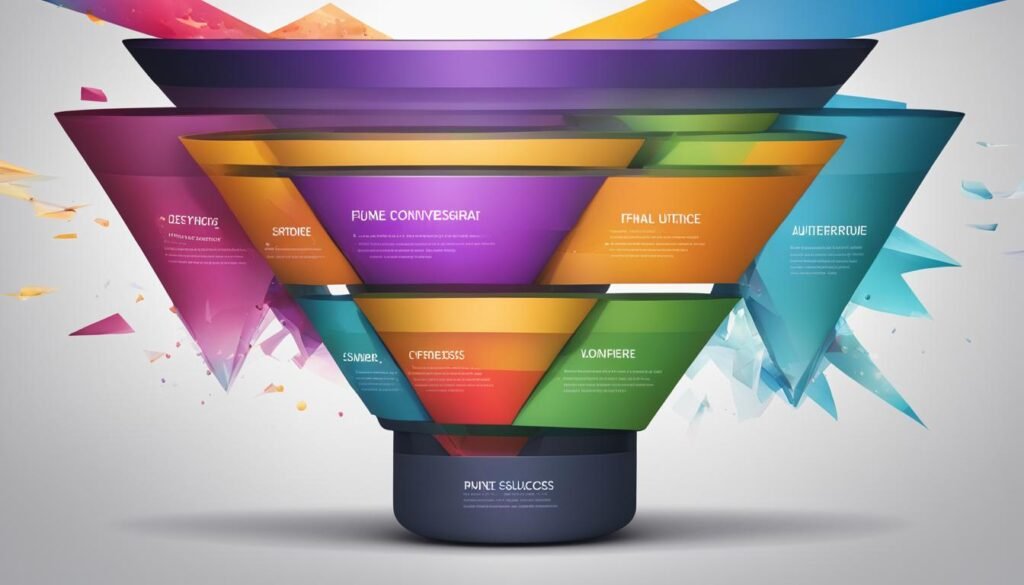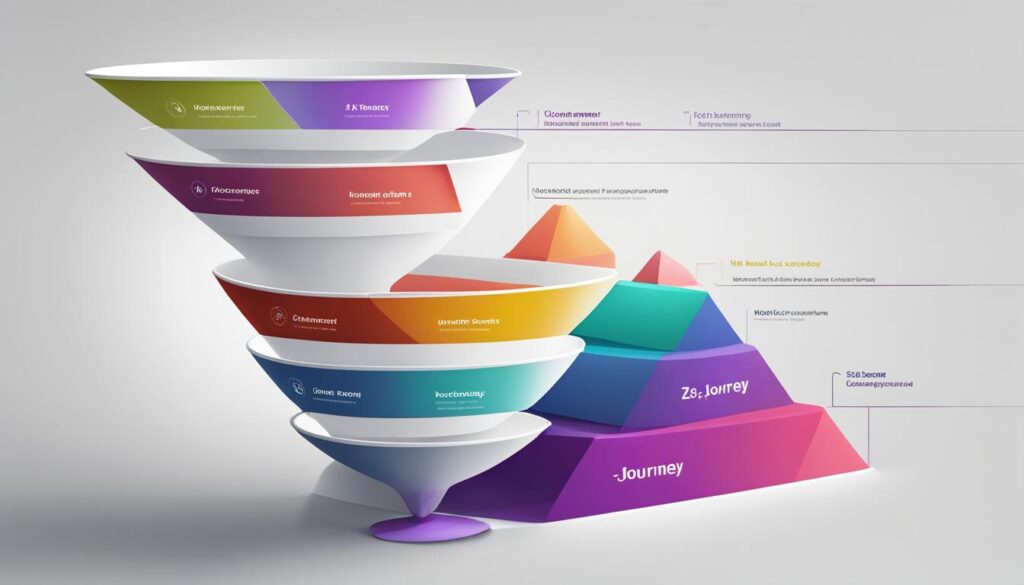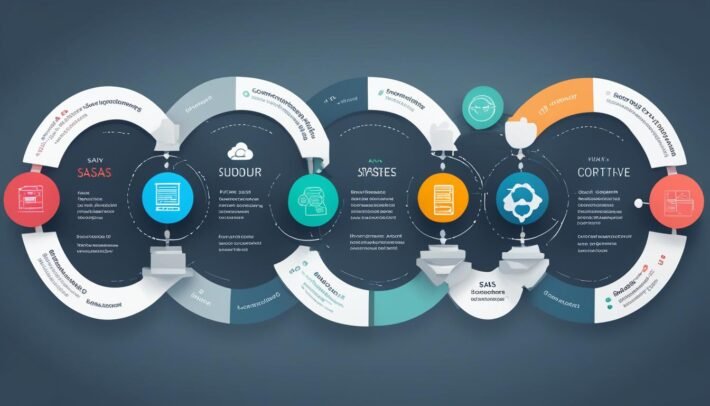Optimizing the SAAS Sales Funnel for Conversions

A well-optimized SAAS sales funnel can help you attract and convert more leads, increasing your revenue and profitability. In this section, we’ll explore the key strategies you need to optimize your SAAS sales funnel and improve your conversion rates.
From understanding the different stages of the funnel to identifying bottlenecks and designing effective landing pages, this guide will equip you with practical tips that you can implement right away to optimize your SAAS sales funnel.
Key Takeaways
- Understanding the stages of the SAAS sales funnel is crucial to optimizing your conversions.
- Analyzing your current funnel can help you identify areas of improvement and measure your progress.
- Creating buyer personas and nurturing prospects through personalized communication can help build trust and drive conversions.
- Streamlining the checkout process and implementing retargeting campaigns can reduce friction and recapture lost prospects.
- Continuous improvement is key to optimizing your SAAS sales funnel over time.
Understanding the SAAS Sales Funnel
The SAAS sales funnel is a framework that maps out the entire customer journey from initial awareness to final purchase. It consists of several stages, with each stage playing a critical role in guiding prospects towards conversion.
The awareness stage is the first stage of the SAAS sales funnel. During this stage, prospects become aware of your SAAS solution, typically through targeted marketing efforts and advertisements. The goal of this stage is to generate interest in your solution and prompt prospects to learn more about it.
The consideration stage comes next, during which prospects evaluate your solution against competitors and weigh the benefits and drawbacks. This stage provides an opportunity to build trust and credibility with prospects by demonstrating your expertise and addressing any concerns they may have.
The decision stage is where the prospect finally makes the purchase decision. At this stage, a well-crafted landing page with a clear call-to-action can make all the difference. By this point, prospects should be fully informed and confident in their decision to choose your SAAS solution.
Each stage in the SAAS sales funnel is crucial, and optimizing each one can increase conversion rates. Understanding the SAAS sales funnel, and how prospects progress through it, is the first step towards improving conversion rates.
Analyzing Your Current Sales Funnel
Before optimizing your SAAS sales funnel, it’s important to evaluate its current performance to identify areas of improvement.
Start by tracking and measuring key performance metrics, such as conversion rates, bounce rates, and time spent on each stage of the funnel. This data will help you identify bottlenecks and areas of low performance.
For example, if you notice a high bounce rate on your landing page, it may be an indication that the page is not optimized for conversions. Or, if prospects are spending a long time in the consideration stage, it may be a sign that your nurturing strategies need improvement.
Consider using tools such as Google Analytics or Mixpanel to measure and analyze your funnel performance. These tools can provide valuable insights into customer behavior and identify opportunities for improvement.
Once you’ve identified areas of improvement, develop a plan to address these issues and optimize your SAAS sales funnel for maximum efficiency.

A visually compelling diagram of your SAAS sales funnel, highlighting each stage and the corresponding metrics, can provide a clear overview of your funnel’s performance. Use this as a reference point to guide your optimization efforts.
Setting Clear Goals and Objectives
To achieve optimal conversions through your SAAS sales funnel, it’s crucial to set clear goals and objectives. Defining your objectives helps to align your efforts, evaluate performance, and identify gaps to optimize the funnel. Your objectives should be SMART: Specific, Measurable, Achievable, Relevant, and Time-bound.
For each stage of the SAAS sales funnel, establish realistic targets and objectives that align with your lead generation and customer acquisition goals. Ensure your objectives are relevant to your customer needs and values, and use data to guide your decision making.
Examples of SAAS Sales Funnel Objectives
| Stage | Objective |
|---|---|
| Awareness | Increase website traffic by 30% within the next quarter through content marketing and social media engagement. |
| Consideration | Generate 50% more leads through webinars and personalized email marketing campaigns in the next six months. |
| Decision | Improve conversion rates by 20% by offering free trials and demos to qualified leads and optimizing the checkout process in the next quarter. |
By setting clear objectives and targets, you can assess whether your SAAS sales funnel is performing optimally, make data-driven decisions, and identify areas for continuous improvement.
Mapping the Customer Journey
Understanding your customer’s journey is key to aligning your SAAS sales funnel stages accordingly. By mapping out the customer journey, you can determine the touchpoints that drive engagement and better optimize the process for ultimate conversions. A customer-centric approach means building the sales funnel around the customer to create a seamless experience.
Creating Buyer Personas
An essential step in mapping the customer journey is creating buyer personas. A buyer persona is a fictional representation of your ideal customer based on market research, data, and any other useful insights. It helps to clarify who your target audience is, their demographic, interests, needs, and specific pain points. Creating a buyer persona ensures that you can tailor your strategy to meet customer expectations throughout the sales funnel.
“Buyer personas help to segment your audience, allowing you to create targeted content and messaging to encourage engagement and conversions.”

Building a Customer-Centric Approach
Ensuring a customer-centric approach throughout the SAAS sales funnel is key to moving prospects through the funnel effectively. By consistently addressing customer needs and pain points, you gain their trust, build brand loyalty, and increase the chances of conversion. Remember that building a customer-centric approach is a process of trial and error, and it requires constant improvement and adjustment.
| Customer Journey Stages | Description |
|---|---|
| Stage 1: Awareness | Customers are made aware of your SAAS solution or product. |
| Stage 2: Consideration | Customers research your solution or similar solutions and compare them. |
| Stage 3: Decision | Customers decide to purchase your SAAS solution or product. |
Understanding the customer’s journey is crucial in optimizing the SAAS sales funnel for conversions. By creating buyer personas and taking a customer-centric approach, you can better align your sales funnel with the customer’s needs and ultimately increase conversions.
Creating Awareness
To optimize your SAAS sales funnel, it is important to create awareness about your solution. Let’s explore some effective strategies to attract prospects and generate interest in your product:
Content Marketing
Content marketing is a powerful way to educate prospects about your product and establish your brand as a thought leader. By creating valuable, engaging content – such as blog posts, ebooks, and webinars – you can attract prospects and build trust with your audience.
Social Media Engagement
Social media platforms are a great way to reach a large audience and drive traffic to your website. By sharing valuable content, engaging with your followers, and running targeted ads, you can generate buzz about your SAAS solution and attract potential customers.
Other Techniques
There are many other techniques you can use to create awareness about your SAAS solution, such as:
- Networking at industry events
- Hosting webinars and workshops
- Guest posting on relevant blogs
- Partnering with other businesses
By implementing a multi-channel approach and testing different techniques, you can discover what works best for your business and effectively reach your target audience.
Nurturing Consideration
Now that prospects are aware of your SAAS solution, it’s time to nurture them through the consideration stage of the sales funnel. At this stage, prospects are actively evaluating your solution, comparing it to competitors, and deciding whether to move forward.
Effective lead nurturing strategies involve personalized communication and providing relevant content to build trust and credibility. Getting to know your prospects’ pain points and tailoring your messaging appropriately can go a long way in establishing a positive relationship.
Lead Nurturing Strategies
Use email marketing to keep your solution top of mind for the prospect. Personalize the message based on the stage of the sales funnel, and make sure to include relevant resources, such as case studies or whitepapers.
Offer a free trial or demo to give prospects a hands-on experience with your SAAS solution. This can help them overcome any doubts or objections they may have.
Provide excellent customer support throughout the consideration stage. Help your prospects through any questions or concerns they may have, and be available to offer guidance when needed. This will demonstrate your commitment to their success, build trust, and keep them engaged.
Personalized Communication
Address prospects by name and personalize your messaging based on their unique interests, needs, and challenges. This will show them that you understand their pain points and are committed to finding a solution that meets their specific needs.
Use chatbots to provide personalized support and answer prospects’ questions in real-time. This can be an effective way to build relationships and provide exceptional customer experiences, all while automating certain parts of the lead nurturing process.
Relevant Content
Create content that speaks directly to your prospects’ pain points, interests, and needs. Use targeted messaging to showcase the unique benefits of your SAAS solution and demonstrate how it can help solve their problems.
Use customer testimonials and case studies to showcase how other businesses have benefited from your SAAS solution. This can help build credibility and trust with prospects, and make them feel more confident in their decision to move forward.

“The key to nurturing consideration is to provide personalized, relevant, and educational content that builds trust and credibility.”
By implementing effective lead nurturing strategies, personalized communication, and providing relevant content, you can build strong relationships with your prospects and increase the likelihood of conversion.
Enhancing the Decision Stage
When prospects are at the decision stage of the SAAS sales funnel, they are close to becoming customers. This is the stage where they will make the final purchasing decision. It is crucial to optimize this stage to increase conversions. Tactics such as free trials, demos, testimonials, and special offers can help encourage prospects to make the final decision.
Free Trials and Demos
Offering free trials and demos is a great way to provide prospects with a hands-on experience of your SAAS solution. This gives them a chance to test your product and make an informed decision. Ensure your free trial or demo is user-friendly and showcases the benefits of your solution clearly. Make it easy for prospects to sign up and get started.
Testimonials and Reviews
Customers trust other customers. Provide prospects with social proof by showcasing customer testimonials and reviews. This can be in the form of quotes, case studies, or video testimonials. Ensure your testimonials are authentic and highlight the benefits of your SAAS solution.
Special Offers
Special offers can be an effective way to encourage prospects to take action. This could be in the form of a discount offer or a limited-time promotion. Ensure your special offers are relevant and add value to your prospects. Use clear and persuasive messaging to communicate the offer clearly.
By optimizing the decision stage of your SAAS sales funnel, you can increase conversions and turn prospects into customers. Use these tactics to encourage prospects to make the final purchasing decision.
Designing an Effective Landing Page
A well-designed landing page can be the difference between a prospect leaving your SAAS funnel and becoming a loyal customer. The landing page should have a clear and concise message, with compelling copy and visual elements that speak to the prospect’s pain points and stir excitement about your solution. Here are a few key principles to follow when designing an optimized landing page:
Compelling Headlines
Your landing page headline needs to capture the reader’s attention and clearly convey the value of your product. Keep it short and snappy while still being informative and catchy. Use attention-grabbing words that speak to the prospect’s needs, and incorporate relevant keywords such as “SAAS sales funnel” to optimize SEO.
Persuasive Copy
The copy on your landing page should be persuasive and focused on benefits rather than features. Outline the solutions your product provides to address pain points, and provide social proof (such as customer testimonials) that your product delivers. Use the active voice, strong action words, and clear calls-to-action to motivate prospects to take action.
Clear Calls-to-Action
Your landing page should have a clear and prominent call-to-action, such as a “Sign Up” or “Request a Demo” button. Use contrasting colors, bolded text, and imagery to make sure it stands out and grabs the reader’s attention. Make sure the call-to-action copy is specific and easy to understand, so the prospect knows exactly what they are signing up for.
Effective Lead Capture Forms
Your lead capture form should be concise and include only the essential fields such as name, email, and company. Use language that reassures the prospect that their information is safe and will not be shared with third parties. Highlight the benefits of signing up and use clear and concise error messages to prompt corrections if necessary.
By following these principles, you can create an optimized landing page that maximizes your SAAS sales funnel conversions and delivers a positive customer experience.
Streamlining the Checkout Process
One of the most critical stages of the SAAS sales funnel is the checkout process. When prospects decide to make a purchase, they want a seamless and straightforward experience. Complicated and lengthy checkout processes can cause prospects to abandon their cart and never return. Therefore, optimizing the checkout process is crucial to maximizing conversions and customer satisfaction.
To streamline the checkout process, consider implementing strategies such as:
- One-click purchasing: This strategy simplifies the checkout process by allowing customers to make a purchase with just one click. It dramatically reduces the waiting time, leading to quicker conversions.
- Guest checkouts: This option allows customers to complete their purchase without creating an account. Not everyone wants to create an account, so providing this option can be beneficial.
- Secure payment gateways: Customers are often hesitant to enter their payment information online. Therefore, it’s crucial to provide secure payment gateways, such as PayPal, Stripe, or Amazon Pay, to increase customer trust and encourage more purchases.
By implementing these strategies, you can reduce friction points, simplify the checkout process, and enhance the overall customer experience. Take time to analyze your checkout process, understand your customers’ needs, and optimize accordingly. A frictionless checkout process can significantly improve conversion rates and win you loyal customers.
Implementing Retargeting Campaigns
Retargeting can be a powerful tool to recapture lost prospects and increase conversion rates in the SAAS sales funnel. By strategically using display ads and personalized messaging, you can re-engage with prospects who have shown interest in your solution.
Retargeting works by placing a small piece of code on your website (a pixel) that drops a browser cookie when someone visits your site. Then, when the prospect visits another site or social media platform, they can be served ads for your SAAS solution, keeping it top of mind and driving them back to finish the conversion process.
Personalized retargeting messages are also a great way to remind prospects of the benefits of your product or service. Use dynamic ads that feature the specific product or service that the prospect was interested in to increase the relevancy of the ad and make it more enticing to click.
Examples of Effective Retargeting Ads:
| Ad Example | Description |
|---|---|
| An ad reminding a prospect of the benefits of a specific feature they were interested in. | |
| A dynamic ad that displays the exact product or service the prospect was interested in. |
Retargeting campaigns can be a valuable addition to your SAAS sales funnel optimization strategies. By staying top of mind with prospects and leveraging personalized messaging, you can increase conversions and drive growth for your business.
Leveraging Customer Testimonials
Customer testimonials are a powerful tool to build trust and credibility for your SAAS solution. Positive feedback from satisfied customers can influence prospects and drive conversions throughout the SAAS sales funnel. To leverage customer testimonials effectively, it’s crucial to gather them consistently and showcase them strategically.
Start by identifying satisfied customers who are willing to provide testimonials for your SAAS solution. Reach out to them and gather detailed feedback on their experience using your product or service. Encourage them to be specific and descriptive to make their testimonials more compelling.
Once you have gathered several customer testimonials, showcase them strategically throughout your SAAS sales funnel. Add testimonials to your landing page to build trust and encourage leads to convert. Use them in email campaigns to provide social proof and increase engagement. Feature them in case studies to show prospects how your SAAS solution has helped other businesses.
When showcasing customer testimonials, be sure to include the customer’s name, title, and company for added credibility. Use quotes or embed video testimonials to make them more engaging. Avoid including fake or overly promotional testimonials, as this can damage your credibility and turn off prospects.
“As soon as we started using [SAAS solution name], our productivity increased by 50%. It’s now an essential part of our daily operations.” – Jane Doe, Marketing Manager at XYZ Inc.
By effectively leveraging customer testimonials, you can convey the value of your SAAS solution and build trust with prospects throughout the sales funnel.
Monitoring and Analyzing Data
Monitoring and analyzing data is crucial in optimizing the SAAS sales funnel. Data provides valuable insights into the effectiveness of your sales funnel, helps identify potential issues, and enables data-driven decision-making.
To track and analyze data, it’s important to use an analytics tool. Google Analytics is one of the most commonly used tools for tracking data in the sales funnel. It’s free to use and provides valuable information on visitor behavior, including how they arrive at your site, what pages they visit, and how long they stay.
One essential metric to track is the conversion rate, which measures the percentage of visitors who take a desired action on your website, such as signing up for a free trial or purchasing your product. By monitoring the conversion rate at each stage of the sales funnel, you can identify bottlenecks and areas for improvement.
Another important metric is the bounce rate, which measures the percentage of visitors who leave your website after only viewing one page. A high bounce rate may indicate issues with your website’s design or messaging that need to be addressed.
Key Takeaways:
- Monitor and analyze data to gain insights into the effectiveness of your sales funnel
- Use an analytics tool like Google Analytics to track important metrics such as conversion rate and bounce rate
- Identify bottlenecks and areas for improvement by monitoring the conversion rate at each stage of the sales funnel
- Address issues with your website’s design or messaging to reduce the bounce rate and improve user experience
A/B Testing for Conversion Optimization
A/B testing, also known as split testing, is a powerful technique to optimize the effectiveness of your SAAS sales funnel and increase conversion rates. By testing different variations of key elements, such as headlines, visuals, and calls-to-action, you can identify the most successful combination for your target audience.
To get started with A/B testing, begin by selecting one element to test. For example, if you want to optimize your landing page, you can test different headlines, images, or button colors. Create two versions of the page, with one element changed in the second version.
Next, use an A/B testing software tool to randomly split your web traffic between the two variations. This will enable you to track and measure the performance of each page. After collecting sufficient data, analyze the results to identify which version performed better.
Best Practices for A/B Testing
- Test one element at a time to obtain reliable data
- Ensure both variations have an equal chance of success, with the same amount of traffic and time frame to run the test
- Collect sufficient data to ensure accuracy (typically a minimum of 100 conversions per variation)
- Focus on the most impactful elements that are likely to affect conversion rates
- Continuously refine and test new variations to keep improving your sales funnel
Implementing a robust A/B testing strategy can help you to optimize your SAAS sales funnel and boost your conversion rates. By testing and refining different elements, you can gain valuable insights into your target audience and better understand what motivates their decision-making process.
Implementing Continuous Improvement Strategies
Optimizing your SAAS sales funnel is not a one-time effort. Continuous improvement is necessary to ensure your funnel remains effective and relevant to your target audience. Here are some techniques to consider:
Implement regular feedback loops:
Encourage customers to provide feedback on their experience with your SAAS solution and sales process. Use the feedback to identify areas for improvement and optimize your sales funnel accordingly.
Conduct customer surveys:
Create a survey to gather information about customer preferences and challenges. The insights gathered from the survey can help you tailor your sales funnel to provide a better customer experience.
Stay up-to-date with industry trends:
Follow industry reports and publications to stay informed of the latest developments in your industry. Keeping up with the trends can help you adapt your sales funnel to remain relevant and effective.
“Continuous improvement is better than delayed perfection.” – Mark Twain
By implementing these techniques and staying focused on optimizing your SAAS sales funnel, you can keep your funnel effective and competitive in the ever-changing market.
Conclusion
In conclusion, optimizing your SAAS sales funnel is crucial to improving conversion rates and achieving business success. By understanding the various stages of the SAAS sales funnel and analyzing key metrics, you can identify areas of improvement and set clear goals and objectives to align your efforts. Mapping the customer journey and creating awareness, nurturing consideration, and enhancing the decision stage are essential strategies to move prospects through the funnel effectively. Designing an effective landing page, streamlining the checkout process, implementing retargeting campaigns, and leveraging customer testimonials can boost conversions.
Monitoring and analyzing data, A/B testing, and implementing continuous improvement strategies are critical for refining and optimizing your SAAS sales funnel over time. By cultivating a mindset of continuous improvement and staying up-to-date with industry trends, you can stay ahead of the competition and achieve long-term success in your SAAS sales funnel optimization efforts.
Remember, optimizing your SAAS sales funnel is an ongoing process that requires constant attention and refinement. By implementing the strategies discussed in this article, you can maximize your SAAS sales funnel efficacy and boost your conversion rates in the long run.
FAQ
What is a SAAS sales funnel?
A SAAS sales funnel refers to the step-by-step process that prospects go through from the initial awareness of your SAAS solution to becoming paying customers. It encompasses stages such as awareness, consideration, and decision, and is designed to guide prospects towards conversion.
Why is optimizing the SAAS sales funnel important?
Optimizing the SAAS sales funnel is crucial as it allows you to maximize your conversion rates, ultimately leading to increased revenue and business growth. By streamlining your customer acquisition process, you can attract and convert more prospects, driving the success of your SAAS business.
How can I analyze my current sales funnel?
To analyze your current SAAS sales funnel, you can track and measure key metrics such as the number of leads, conversion rates, and customer retention. Analyzing these data points will help you identify any bottlenecks or areas of improvement within your sales funnel.
Why is setting clear goals and objectives important for optimizing the SAAS sales funnel?
Setting clear goals and objectives for each stage of the SAAS sales funnel is vital as it allows you to align your efforts and resources towards optimizing conversions. By establishing realistic targets, you can focus on implementing strategies that effectively move prospects through the sales funnel.
How can I create awareness for my SAAS solution?
There are several strategies to generate awareness for your SAAS solution, including content marketing, social media engagement, and targeted advertising. By creating valuable content and engaging with your target audience, you can attract prospects and generate interest in your SAAS offering.
How can I nurture prospects in the consideration stage?
To nurture prospects in the consideration stage, you can implement lead nurturing strategies such as personalized communication and providing relevant content. Building trust and credibility through tailored interactions will increase the chances of prospects choosing your SAAS solution.
How can I enhance the decision stage of the SAAS sales funnel?
To enhance the decision stage, you can offer prospects incentives such as free trials, demos, testimonials, and special offers. These tactics help potential customers feel more confident in their decision to choose your SAAS solution, increasing conversion rates.
What are the key principles for designing an effective landing page?
Designing an effective landing page involves creating compelling headlines, persuasive copy, clear call-to-actions, and effective lead capture forms. Simplifying the user experience and making it easy for prospects to take the desired action will boost conversions.
How can I streamline the checkout process?
You can streamline the checkout process by simplifying it and minimizing friction points. Strategies such as one-click purchasing, guest checkouts, and secure payment gateways can help provide a seamless customer experience, leading to higher conversion rates.
How can retargeting campaigns help increase conversion rates?
Retargeting campaigns allow you to re-engage with prospects who have shown interest in your SAAS solution but have not yet converted. By strategically using display ads and personalized messaging, you can remind these prospects about your offering and encourage them to take action.
How can I leverage customer testimonials in my SAAS sales funnel?
Customer testimonials can influence prospects by providing social proof and building trust. Gathering and showcasing positive feedback throughout your SAAS sales funnel will help potential customers feel confident in choosing your solution, ultimately boosting conversions.
Why is monitoring and analyzing data important in optimizing the SAAS sales funnel?
Monitoring and analyzing data allows you to track conversion rates, identify trends, and make data-driven decisions. By leveraging analytics tools, you can gain valuable insights into the effectiveness of your sales funnel and make targeted improvements.
How can A/B testing help optimize the SAAS sales funnel?
A/B testing involves testing different variations of elements within your sales funnel, such as headlines, visuals, or calls-to-action. By comparing the performance of these variations, you can identify the most effective elements and make data-backed decisions to improve conversions.
What are some continuous improvement strategies for optimizing the SAAS sales funnel?
Continuous improvement strategies involve implementing feedback loops, conducting customer surveys, and staying up-to-date with industry trends. By constantly refining and optimizing your sales funnel, you can adapt to changing customer needs and stay ahead of the competition.



